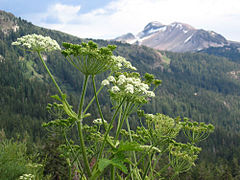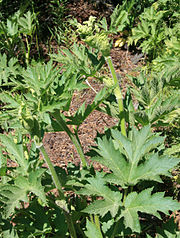- Cow Parsnip
-
Not to be confused with Parsnip.
Cow Parsnip Scientific classification Kingdom: Plantae (unranked): Angiosperms (unranked): Eudicots (unranked): Asterids Order: Apiales Family: Apiaceae Genus: Heracleum Species: H. maximum Binomial name Heracleum maximum
BartramSynonyms Heracleum lanatum Michx.
The Cow Parsnip (Heracleum maximum also known as Indian Celery or Pushki) is the only member of the genus Heracleum native to North America. Its classification has caused some difficulty, with recent authoritative sources referring to it variously as Heracleum maximum or Heracleum lanatum , as H. linatum, or as either a subspecies, H. sphondylium subsp. montanum, or a variety, H. sphondylium var. linatum, of the Common Hogweed (H. sphondylium). The classification given here follows ITIS.
Contents
Distribution
The Cow Parsnip is distributed throughout most of the continental United States except the Gulf Coast and a few neighboring states. It occurs from sea level to about 9000ft[1], and is especially prevalent in Alaska. It is listed as "Endangered" in Kentucky and "Special Concern" in Tennessee. In Canada, it is found in each province and territory, except Nunavut. It may be weedy or invasive in portions of its range.[2]
Characteristics
The Cow Parsnip is a tall herb, reaching to heights of over two meters. The genus name Heracleum (from "Hercules") refers to the very large size of all parts of these plants[3]. Cow Parsnip has the characteristic flower umbels of the carrot family (Apiaceae), about 20 cm across; these may be flat-topped, as in the pictures above, or more rounded, and are always white. Sometimes the outer flowers of the umbel are much larger than the inner ones, as in the top image. The leaves are very large, up to 40 cm across, divided into lobes (see image). The stems are stout and succulent. The seeds are 8-12mm long and 5-8mm wide[1] (seedheads shown in image).
Uses
The juices of all parts contain a phototoxin that can act on contact with skin and exposure to ultraviolet light, causing anything from a mild rash to a blistering, severe dermatitis, depending on the sensitivity of the individual. The plant is a pernicious weed especially in pastures, where it can ruin the milk of cows that eat it.
Various Native American peoples had many different uses for this plant; all parts of it were used by one nation or another. Perhaps the most common use was to make poultices to be applied to bruises or sores. In addition, the young stalks and leaf stems — before the plant reaches maturity — were widely used for food with the outer skin peeled off giving a sweetish flavor. The dried stems were also used as drinking straws for the old or infirm, and to make flutes for children. A yellow dye can be made from the roots, and an infusion of the flowers can be rubbed on the body to repel flies and mosquitoes.[4]
Similar species
The water parsnip (Sium suave), western water hemlock (Cicuta douglasii), and spotted water hemlock (Cicuta maculata) all have white flowers in large compound umbels and therefore are easily confused with cow parsnip. Water parsnip and water hemlock both have clusters of small white flowers shaped like umbrellas, and both have the same habitat near the shore line of lakes, and rivers. Water parsnip has leaves only once compound, and water hemlock has leaves which are three times compound. Water hemlock has a large swelling at the stem base. All water hemlock is highly poisonous.[5] Water parsnip is not poisonous.[6] The water hemlock has bracts at the base of each small flower cluster, not at the base of the main flower head.[7] The Water parsnip has small bracts at the base of flowers and main flower head as well.[8]
The yarrow (Achillea millefolium) also has many small white flowers in a cluster. However, the yarrow has feathery looking leaves which are pinnately separated into small narrow segments.[9]
The cow parsnip and hogweed can be confused in this group with similar flower groupings. However, the cow parsnip has large, broad leaves, and an unpleasant odour.[10]
External links
- Jepson Manual species treatment
- Images from the CalPhotos archive
- Images from the Connecticut Botanical Society
- Plants for a Future report on the species
References
- ^ a b Norman F. Weeden (1996), A Sierra Nevada Flora, Wilderness Press, ISBN 0-89997-204-7
- ^ "Heracleum maximum Bartram". PLANTS Profile. United States Department of Agriculture; Natural Resources Conservation Service. http://plants.usda.gov/java/profile?symbol=HEMA80. Retrieved 2008-03-30.
- ^ Elizabeth L. Horn (1998), Sierra Nevada Wildflowers, Mountain Press, ISBN 0-87842-388-5
- ^ University of Michigan Ethnobotany
- ^ "Cicuta maculata.". http://www.em.ca/garden/native/nat_cicuta_maculata.html. Retrieved 2008-08-03.[dead link]
- ^ "Traditional Plant Foods of Canadian Indigenous Peoples By Harriet V Kuhnlein, Nancy J.". Google books. http://books.google.ca/books?id=fPDErXqH8YYC&pg=PA124&lpg=PA124&dq=hemlock++saskatchewan&source=web&ots=wEZs3Qy1Nb&sig=4XiR4NlX_41oreXB54L841HnbIs&hl=en&sa=X&oi=book_result&resnum=10&ct=result#PPA124,M1. Retrieved 2008-08-03.
- ^ "Western Water Hemlock - Agriculture - Government of Saskatchewan". http://www.agriculture.gov.sk.ca/Default.aspx?DN=6896bcb3-d202-43e0-ace9-c4ec72d8835d. Retrieved 2008-08-03.
- ^ "Water Parsnip - Agriculture - Government of Saskatchewan". http://www.agriculture.gov.sk.ca/Default.aspx?DN=e2b0945b-6609-4790-ae82-8fdd9135af26. Retrieved 2008-08-03.
- ^ "Yarrow Achillea millefolium". http://www.em.ca/garden/native/nat_Achillea%20millefolium.html. Retrieved 2008-08-03.
- ^ "Heracleum lanatum". University of Saskatchewan. http://www.usask.ca/agriculture/plantsci/classes/range/heracleum.html. Retrieved 2008-08-03.
Categories:- Apiaceae
- Flora of the West Coast of the United States
- Flora of California chaparral and woodlands
- Flora of Appalachia (United States)
- Flora of the Northern United States
- Flora of the Eastern United States
- Flora of the United States
- Flora of Canada
- Flora of Alaska
- Flora of Kentucky
- Flora of Tennessee
- Medicinal plants
Wikimedia Foundation. 2010.



